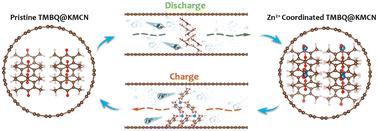当前位置:
X-MOL 学术
›
Energy Environ. Sci.
›
论文详情
Our official English website, www.x-mol.net, welcomes your feedback! (Note: you will need to create a separate account there.)
Unveiling nanopore-confined crystallization and coordination/de-coordination mechanisms of quinone molecules for ultrahigh-rate and ultralong-cyclability aqueous zinc–organic batteries
Energy & Environmental Science ( IF 32.4 ) Pub Date : 2024-06-10 , DOI: 10.1039/d4ee01560f Shuo Meng 1, 2 , Ting He 1, 2 , Lu Chen 1 , Kexuan Liao 1 , Hang Lu 1 , Tingting Liu 1 , Ruijin Meng 3 , Jie Ma 4 , Chi Zhang 1, 2 , Jinhu Yang 1, 2
Energy & Environmental Science ( IF 32.4 ) Pub Date : 2024-06-10 , DOI: 10.1039/d4ee01560f Shuo Meng 1, 2 , Ting He 1, 2 , Lu Chen 1 , Kexuan Liao 1 , Hang Lu 1 , Tingting Liu 1 , Ruijin Meng 3 , Jie Ma 4 , Chi Zhang 1, 2 , Jinhu Yang 1, 2
Affiliation

|
Impregnating organic small molecules into porous carbon matrices is a prevailing strategy for aqueous zinc–organic batteries to address the problem of dissolution and conductivity of organic active materials for better performance. However, fundamental principles such as the nanopore-confined behavior of organic molecules and related electrochemical mechanisms are still unclear to date. Herein, we disclose that a “nanopore-confined metal–organic coordination chemistry” involving space-confined crystallization of quinone molecules and subsequent highly reversible Zn2+ coordination/de-coordination reactions with crystalline quinone molecule clusters within a porous carbon matrix enables superior performance for aqueous zinc–organic batteries, which is realized via a novel three-in-one strategy. The strategy integrating pore structure modulation, loading technique optimization and organic molecule selection can realize a high loading yet anti-dissolution of tetramethyl-benzoquinone (TMBQ) in a KOH activated MOF-derived carbon nanocage (KMCN), ensuring insolubility of organic active materials and fast Zn2+ diffusion kinetics. Consequently, the resultant TMBQ@KMCN cathode delivers a high reversible capacity of 315 mA h g−1 at 0.5C, an unprecedented high rate capability of 155 mA h g−1 at 150C (48.9 A g−1), and an ultralong cycle life of 15 000 cycles at 20C with a capacity retention of 91.2%. This work provides important insights and guidance for designing high-performance organic electrode materials.
中文翻译:

揭示用于超高倍率和超长循环水性有机锌电池的醌分子的纳米孔限制结晶和配位/去配位机制
将有机小分子浸渍到多孔碳基质中是水系锌有机电池的一种流行策略,旨在解决有机活性材料的溶解和导电性问题,以获得更好的性能。然而,有机分子的纳米孔限制行为和相关电化学机制等基本原理迄今为止仍不清楚。在此,我们公开了一种“纳米孔限制的金属有机配位化学”,涉及醌分子的空间限制结晶以及随后与多孔内结晶醌分子簇的高度可逆的 Zn 2+ 配位/去配位反应。碳基质使水性锌有机电池具有卓越的性能,这是通过一种新颖的三合一策略实现的。结合孔结构调控、负载技术优化和有机分子选择的策略可以在KOH活化的MOF衍生碳纳米笼(KMCN)中实现四甲基苯醌(TMBQ)的高负载且抗溶解,确保有机活性材料的不溶性和快速 Zn 2+ 扩散动力学。因此,所得的TMBQ@KMCN阴极在0.5C时具有315 mAh g −1 的高可逆容量,在150C时具有前所未有的155 mAh g −1 的高倍率能力(48.9 A g −1 ),20C下超长循环寿命达15000次,容量保持率为91.2%。这项工作为设计高性能有机电极材料提供了重要的见解和指导。
更新日期:2024-06-10
中文翻译:

揭示用于超高倍率和超长循环水性有机锌电池的醌分子的纳米孔限制结晶和配位/去配位机制
将有机小分子浸渍到多孔碳基质中是水系锌有机电池的一种流行策略,旨在解决有机活性材料的溶解和导电性问题,以获得更好的性能。然而,有机分子的纳米孔限制行为和相关电化学机制等基本原理迄今为止仍不清楚。在此,我们公开了一种“纳米孔限制的金属有机配位化学”,涉及醌分子的空间限制结晶以及随后与多孔内结晶醌分子簇的高度可逆的 Zn 2+ 配位/去配位反应。碳基质使水性锌有机电池具有卓越的性能,这是通过一种新颖的三合一策略实现的。结合孔结构调控、负载技术优化和有机分子选择的策略可以在KOH活化的MOF衍生碳纳米笼(KMCN)中实现四甲基苯醌(TMBQ)的高负载且抗溶解,确保有机活性材料的不溶性和快速 Zn 2+ 扩散动力学。因此,所得的TMBQ@KMCN阴极在0.5C时具有315 mAh g −1 的高可逆容量,在150C时具有前所未有的155 mAh g −1 的高倍率能力(48.9 A g −1 ),20C下超长循环寿命达15000次,容量保持率为91.2%。这项工作为设计高性能有机电极材料提供了重要的见解和指导。






































 京公网安备 11010802027423号
京公网安备 11010802027423号